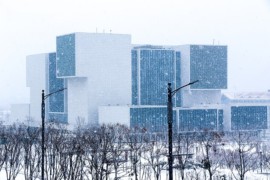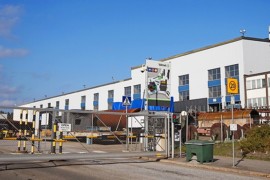The quality of the water circulating in heating networks is absolutely essential for optimal performance. Romain Jombart, marketing manager for formulated products division with BWT in France explains the risks and treatment options.
Can you present your company?
BWT France is a subsidiary of the BWT Group which employs about 3000 people, mostly in Europe, with our headquarters based in Austria. We specialize in the design, manufacture and sale of equipment and chemicals for water treatment and their associated services.
More particularly, we work in all types of buildings, via technologies aimed at transforming the water in order to adapt it for specific needs and uses. We cover a fairly large area and many activities: water treatment for the manufacture of vaccines, for cooking, for swimming pools … and also for heat networks.
In which contexts do you intervene in heating networks?
We work on all the skills required in these networks: equipment, chemicals and analytical monitoring. Our principal clients are installers and heating operators. We are in charge of the project right from the start, working alongside design offices and engineering consultants to ensure the adoption of best practices in the field of water treatment in the installation of equipment, surface preparation for those surfaces which are in contact with water, as well as in the operating phase itself, and thus in the long-term protection of heating networks.
Why do water heating systems need to be treated?
Whether the water comes from a town, from a bore hole or ground water, raw water represents a significant risk to the pipeline in the absence of treatment. The problems associated with untreated water can be summarized into three main issues: scale, corrosion and sludge.
Tartar develops from calcium and magnesium salts that naturally contain water. By subjecting them to pressure and high temperatures, these cold-soluble salts are no longer soluble and precipitate to form quite a hard deposit.
Corrosion on the other hand is predominantly caused by oxygen dissolved in water. It is especially pernicious on ferrous metals such as steel which is exactly the material used in the pipes of heating networks.
Finally, the third concern, sludge, which can have one of two origins. It can come from poor treatment of surfaces prior to them being filled with water or from welding residues, grease or scale. Without treatment, these elements will find themselves suspended in water and pose a potential risk of sludge formation, with implications for corrosion deposits, cavitation and thermal performance loss. However, the sludge may also be derived from a combination of scale and corrosion in an operating circuit. In all cases, the occurrence of these phenomena can accelerate the emergence of another and causes deterioration of the structure as well as significant loss of thermal efficiency.
Are there also bacterial risks?
Yes, but this is rarer in heating networks because the conditions of pressure and temperature conditions are generally not conducive to the growth of bacteria. However, there are exceptions, in particular in the case of SSB, a sulphate reducing bacterium that, as part of its metabolism, releases hydrogen sulphide, which is particularly aggressive towards steel. It is found in low oxygen environments, from the water originating in wells or aquifers. In heating networks, reducing oxygen treatments may also encourage their development.
What features have you put in place to counter these risks?
To combat scale, there are two main methods. The first is to soften the water by removing calcium and magnesium ions and replacing them with sodium ions. This ion exchange technique may be further extended to the demineralization of water to avoid precipitation, in particular for heating networks operating at very high pressures and temperatures, for example in vapour networks.
In addition to ion exchange techniques, we also inject anti-scale additives based on organic or inorganic dispersants, which primarily come from phosphate chemistry, but also natural products such as tannins or synthetic polymers (acrylic polymer, example).
Since corrosion is mainly linked to oxygen dissolved in water, we primarily use oxygen reducers, the main ones being sulphites. These are fairly simple and inexpensive compounds. In some networks with medium and high pressure, we may be obliged to use organic reducers such as DEHA (diethyl hydroxylamine) or carbohydrazide, which are more resistant to decay than sulphites. Finally, we work with corrosion inhibitors for metal surfaces for both anodes and cathodes. The former are simple molecules such as orthophosphates which, by reacting with the iron piping, will form a protective layer and insulate the metal (this is known as the passivation phenomenon of so-called anodic parts). While the latter involves a precipitate on the treated surfaces to prevent oxygen from attacking them (blocking the chemical reduction of oxygen at the cathode).
Do these devices also reduce the risk of sludge forming?
Yes, but as a precaution, we must also address this issue. First, the surfaces must be prepared using chemical cleaning agents. This is essentially the addition of surfactants and dispersants which are used to remove grease residues or deposits on the new circuits. We also recommend that a magnetic or cyclone filter bag be installed, in either total filtration or stream filtration, which will retain the particles in suspension in the operating phase. Generally, we place them in the central unit and before the boilers to protect the generators.
Are these treatments the same in both heating and cooling networks?
Generally, yes, but there are some nuances. Scale, for example, will form more quickly in hot temperatures than cold, this phenomenon is a serious handicap for heating networks. It is less critical for cooling networks, as it can be limited using simple chemical techniques. Conversely, iced water is rich in dissolved oxygen and therefore capable of corrosion. Yet for cold water, the tendency is not to make use of oxygen scavengers. Firstly, because it would generate large concentrations of harmful by-products in the installations, secondly because it would consume too great a quantity of products. So we work mainly using anodic and cathodic inhibitors. For example, molybdates are excellent anodic inhibitors.
Are you exploring any innovative solutions?
Increasingly, we are working on two approaches: curative and preventive. On a curative level, we are developing, in conjunction with the Solutech company, mild cleaning solutions under technical advice and which have given excellent results. Regarding the preventive approach, we have marketed products originating from plant chemistry for quite some time. These are tannins, for example, which are natural molecules extracted from chestnut or mimosa and which combine reducing properties and dispersant properties. These products also include lignosulfonates, from wood fibres, which have very effective dispersing and anti-tartar properties.
How important is it to monitor the water quality of the networks?
It is essential. You can have the best treatments in the world, but you simply cannot ignore a relevant analytical monitoring. The difficulty of heat networks is that they are relatively large and very large. This can produce water quality changes from one point to another in a circuit (oxygenation difference, flow velocity, temperature …). We cannot simply inject a treatment product in the central unit and analyse the water returning to the unit and estimate that this analysis is representative. Any number of events may occur in the grid. Hence the importance of a precise mapping with sampling points and the treatment adapted if necessary at all these points.
What is the cost of treating water in heating networks?
In general, the cost of chemical treatment is of the order of € 10 per m3. For the filtration process, the cost is, including installation, 5 000 to 8 000 € depending on the flow rate. The initial water softening device costs between €5000 and €10 000. However, as heating networks use little water, the operating costs are limited.






